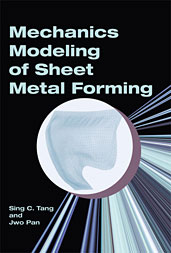Journal Article
Closed-Form Structural Stress Solutions for Spot Welds in Square Plates under Central Bending Conditions
2019-04-02
2019-01-1114
A new closed-form structural stress solution for a spot weld in a square thin plate under central bending conditions is derived based on the thin plate theory. The spot weld is treated as a rigid inclusion and the plate is treated as a thin plate. The boundary conditions follow those of the published solution for a rigid inclusion in a square plate under counter bending conditions. The new closed-form solution indicates that structural stress solution near the rigid inclusion on the surface of the plate along the symmetry plane is larger than those for a rigid inclusion in an infinite plate and a finite circular plate with pinned and clamped outer boundaries under central bending conditions. When the radius distance becomes large and approaches to the outer boundary, the new analytical stress solution approaches to the reference stress whereas the other analytical solutions do not.

